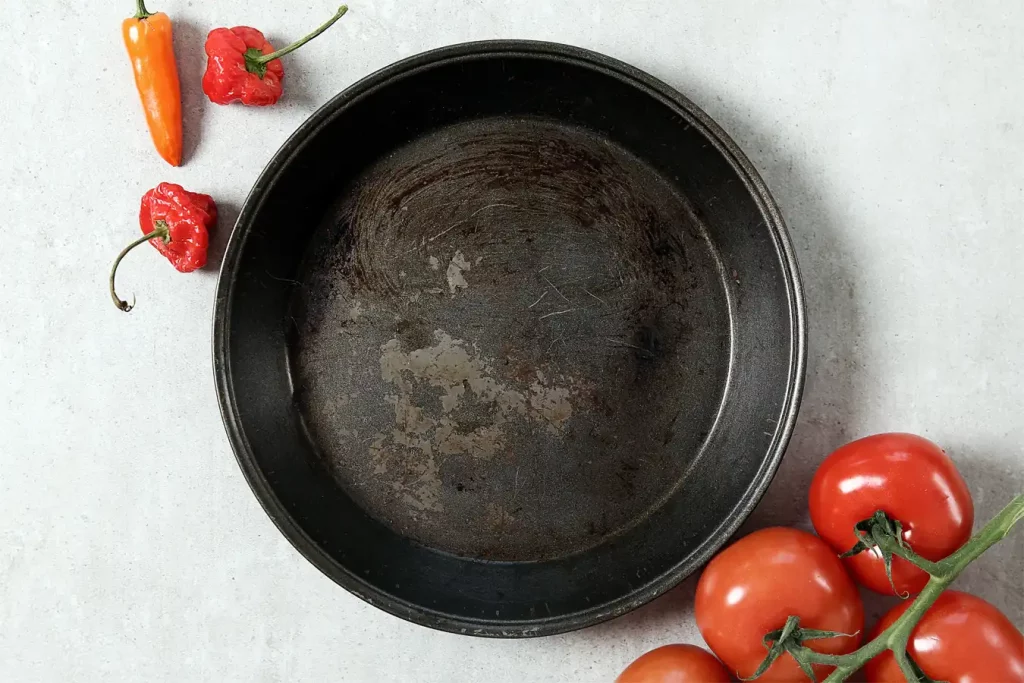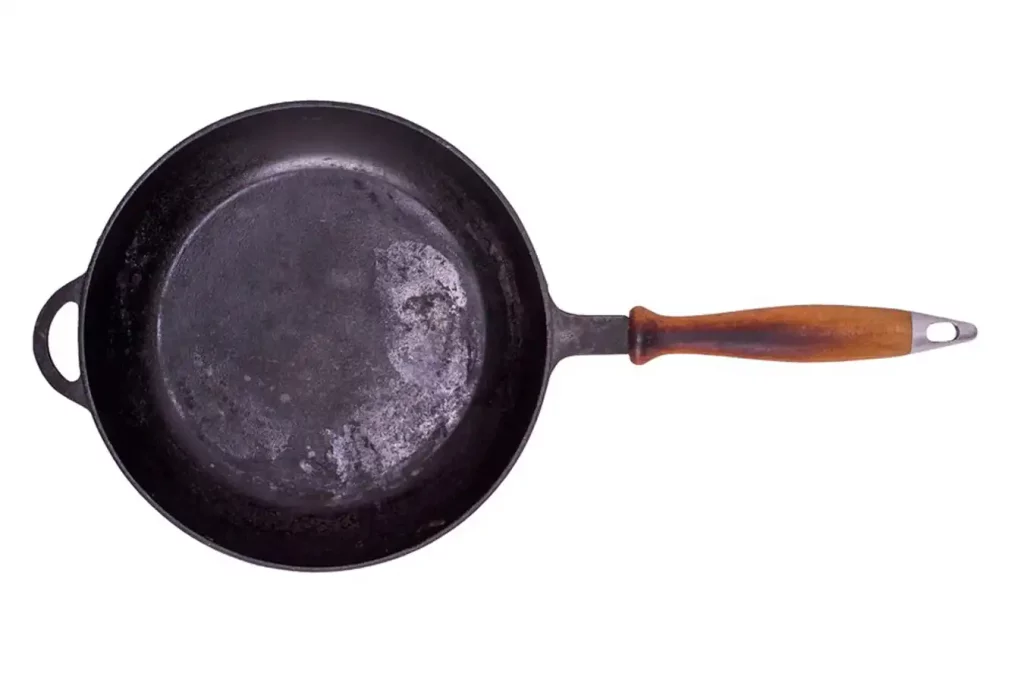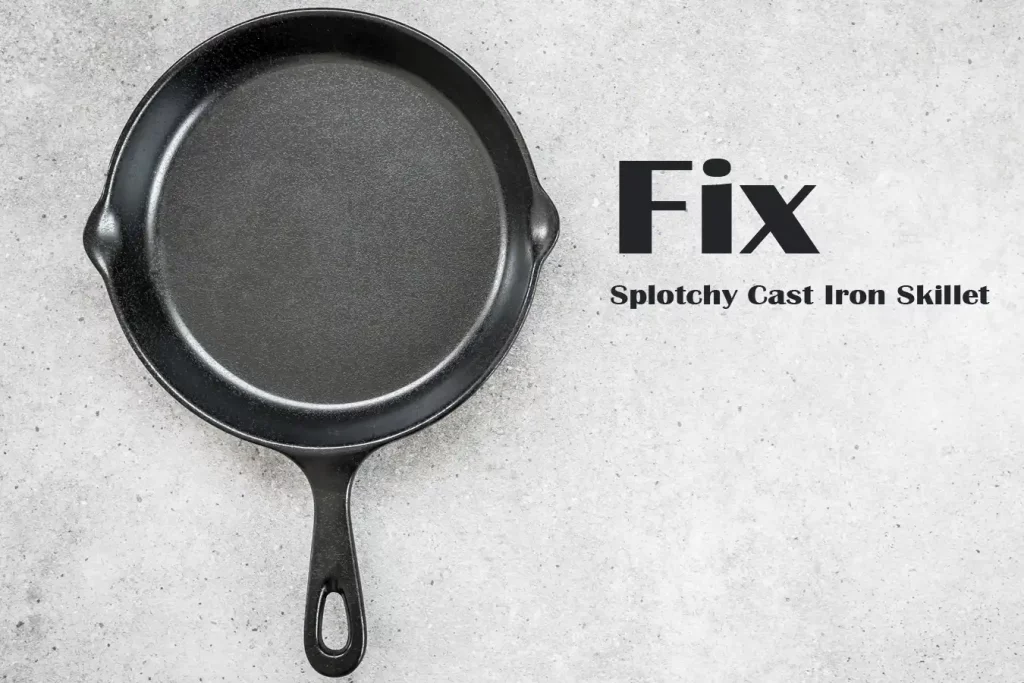Hello, kitchen warriors! Wondering how to fix splotchy cast iron skillet?
You’ve found your compass in this easy restoration guide designed to rectify that unsightly splotchiness.
Together, we’ll walk through a series of practical steps that’ll make your skillet gleam like new, without any of the fuss.
As your friendly outdoorsy guide, I’m thrilled to help you tackle this kitchen quandary with aplomb.
Ready to roll up your sleeves and bring back the shine? Your skillet revival journey starts now!
The Science Behind Splotchy Cast Iron
Before we dive into the solutions, let’s first understand the problem. What exactly is happening when your cast iron pan turns splotchy? Is it a sign of misuse, or is it just an inevitable consequence of use? To answer these questions, we need to look at two key aspects: what happens to untreated cast iron and the role of seasoning.

Explanation of What Happens to Untreated Cast Iron
Cast iron is a remarkably durable material. However, like any superhero, it also has its Achilles’ heel: oxidation. When exposed to air and moisture, iron tends to rust. This process of oxidation gives rise to those reddish-brown spots that we all dread.
The splotchiness, however, is not solely about rust. It’s also about the pan’s exposure to heat, food residue, and even the type of food you cook. Foods with high acidity, like tomatoes, can strip the pan’s seasoning, causing some parts to darken faster than others.
The Role of Seasoning in Maintaining Cast Iron
Now, onto the superhero’s shield: seasoning. Seasoning is a process of baking oil onto the cast iron to create a non-stick layer. This layer not only makes your cooking experience smoother but also protects the iron from oxidation.
However, the layer isn’t invincible. High heat, abrasive cleaning methods, and acidic foods can damage it, leading to a splotchy appearance. And this, my friends, is where our next chapter begins. Stay tuned as we’ll soon dive into how to restore your splotchy cast iron to its former glory.
Remember, as in any journey, understanding the path is half the battle won. So, take heart, keep your cast iron close, and let’s get ready to embark on our restoration journey. It may be a little rocky, but as any outdoor enthusiast knows, the best views come after the hardest climbs.
Identifying Splotchy Cast Iron
Identifying splotchy cast iron is a critical first step in the journey towards restoration. Here, we need to observe and understand the signs that our trusty cast iron cookware is showing us. Let’s talk about what a splotchy cast iron looks like and when it’s necessary to take action to fix it.
What Does Splotchy Cast Iron Look Like?
The appearance of splotchy cast iron can vary significantly, but it often presents as patches of discoloration across the surface of the cookware. You might see patches that are darker or lighter than others. Sometimes, these areas are glossy, while others may appear dull.

In more severe cases, you might even see spots of rust – a telltale reddish-brown color. These spots are typically a sign that the protective seasoning layer has been breached, allowing the iron to oxidize.
When is it Necessary to Fix a Splotchy Cast Iron?
The short answer is – it depends. A little discoloration doesn’t mean your cast iron is in a state of disrepair. Cast iron cookware is hardy, and small patches of splotchiness can be part and parcel of its use over time.
However, when you notice significant discoloration, particularly rusty spots, it’s time to act. Rusty areas can affect your food’s taste and could potentially be harmful if ingested. Similarly, if your food starts sticking to the pan more than usual, it may indicate a damaged seasoning layer, warranting your attention.
Necessary Tools and Materials for Fixing Splotchy Cast Iron
Repairing your splotchy cast iron cookware might seem daunting, but I assure you, it’s quite manageable with the right tools and materials. Let’s take a look at what you need to get your beloved cookware back in shape.
Equipment and Ingredients Needed
The tools needed for this task are likely already in your kitchen. Here’s what you’ll need:
- Your splotchy cast iron cookware
- Steel wool or a coarse sponge
- Dish soap
- Vegetable oil (or your preferred seasoning oil)
- An oven
As you can see, nothing too fancy or hard to find!
Choosing Suitable Cleaning and Seasoning Agents
For cleaning, a mild dish soap and a piece of steel wool or a coarse sponge should do the trick. While there’s a common myth that soap harms cast iron’s seasoning, a little amount won’t hurt, especially as we’re re-seasoning the pan.
As for the oil, you can use a variety of types. Many folks swear by vegetable oil, while others prefer flaxseed oil for its hardening properties when heated. The choice is yours, and it largely depends on your personal preference and what you have on hand.
In our upcoming sections, we’ll walk through the steps of how to utilize these tools to restore your splotchy cast iron. So, don your apron and prepare for a little kitchen adventure!
Step-by-Step Guide to Fix Splotchy Cast Iron
Fixing splotchy cast iron might sound like a chore, but it’s actually a rather satisfying process. All it requires is a little bit of patience and a few simple steps. This section will guide you through the entire process of restoring your cast iron to its former glory.
Preparatory Steps Before Fixing Splotchy Cast Iron
Before we start repairing the splotchy spots on your cast iron, we have some preparatory steps to take care of.
Step 1: Cleaning the Cast Iron
First things first – give your cast iron a good cleaning. This step is essential to remove any excess food particles and initial rust or discoloration.
To clean, scrub your cookware with mild dish soap and steel wool or a coarse sponge. Be thorough but not overly aggressive – you want to keep as much of the underlying seasoning intact as possible. Rinse well under warm water.
Step 2: Drying the Cast Iron
After washing, dry your cast iron immediately to prevent additional rust from forming. Use a towel to dry it thoroughly. Once done, place it on a stove burner over low heat for a few minutes to evaporate any remaining moisture.
The Process of Fixing Splotchy Cast Iron
With our cast iron cleaned and dried, it’s time to start the actual repair process.
Step 3: Applying a Coat of Seasoning
Once your cast iron is bone dry, it’s time to apply a fresh coat of seasoning. Dab a small amount of your chosen oil onto a paper towel or cloth and rub it all over the cookware – inside and out. It should be a thin layer; too much oil can create a sticky surface.
Step 4: Heating the Cast Iron
Preheat your oven to 450-500°F. Then, place your oiled cast iron upside down on the center rack. This heating process allows the oil to polymerize, creating a hard, protective layer over the cast iron. Bake it for an hour.
Finishing and Post-Treatment Steps
Once we’re done baking the cast iron, it’s time for some finishing touches.
Step 5: Cooling and Repeating the Process
Turn off the oven and let your cast iron cool in there gradually. Once it’s cool enough to handle, you can repeat the oiling and heating process as many times as needed to achieve a black, shiny surface. A good rule of thumb is to repeat it at least 3 times for optimal results.
Step 6: Storing the Cast Iron
Now that your cast iron has a fresh coat of seasoning, store it in a dry place with the lid off to prevent moisture buildup. It’s a good idea to place a paper towel inside to absorb any excess moisture.
Your once-splotchy cast iron is now rejuvenated, ready to whip up your favorite meals with that irreplaceable depth of flavor only cast iron can provide.
Learn more: Remove Carbon Buildup on Cast Iron Skillets
Tips and Warnings for Fixing Splotchy Cast Iron
Fixing splotchy cast iron is no Herculean task, but it does demand a certain level of diligence. Like most things in life, the devil is in the details. To help you avoid common pitfalls, here are some best practices and safety precautions to take note of during the process.
Best Practices and Things to Avoid
When it comes to maintaining your cast iron, a few things are critical to keep in mind:
- Use the right tools: Always opt for non-metallic brushes or pads for cleaning to avoid scratching the surface.
- Avoid acidic foods: Cooking acidic foods like tomatoes or citrus-based sauces can eat away at the seasoning and lead to splotchiness.
- Oil selection matters: High-smoke point oils like canola, vegetable, or grapeseed are ideal for seasoning cast iron. Steer clear of butter or olive oil, which can leave a sticky residue.
- Avoid drastic temperature changes: This can cause the cast iron to crack or warp. Allow it to cool down naturally after heating before washing.
- Re-season regularly: Even with perfect care, your cast iron will need re-seasoning over time. Make it a habit to refresh the seasoning whenever it starts looking dull.
Safety Precactions During the Process
While fixing splotchy cast iron is not particularly hazardous, it’s always wise to adhere to basic safety measures:
- Protect your hands: Always use oven mitts or heat-resistant gloves when handling hot cast iron to avoid burns.
- Ensure good ventilation: If you’re using your oven for seasoning, ensure there’s adequate ventilation to avoid the smoke setting off your fire alarm.
- Dispose of oily rags properly: Oily rags can spontaneously combust if not properly disposed of. Always store them in a sealed, water-filled container before disposal.
To know more: How to Deglaze a Cast Iron Skillet
FAQs about Fix Splotchy Cast Iron Skillet
Why does my cast iron look blotchy?
Why is my cast iron seasoning spotty?
Why does my cast iron skillet look spotty?
How do you fix cast iron discoloration?
How do you fix heat damage on cast iron?
How do you even out a cast iron skillet?
Conclusion
Reclaiming the uniform, non-stick surface of your cast iron cookware is worth every bit of effort it takes. Not only does it extend the life of your prized kitchenware, but it also enhances your culinary experience. Splotchy cast iron is not the end of the world, nor the end of your cookware. With a little time, patience, and the right techniques, you can restore it to its original glory.
So, the next time you spot a splotchy patch on your favorite skillet, don’t panic. Roll up your sleeves, gather your tools, and remember this guide. Happy cooking!
My name is Ovi Tanchangya, a passionate blogger and outdoor enthusiast. I hope this guide was helpful to you and that it encourages you to embrace the joy of maintaining your own cast iron. After all, the flavorsome meals that result are worth every bit of effort.


